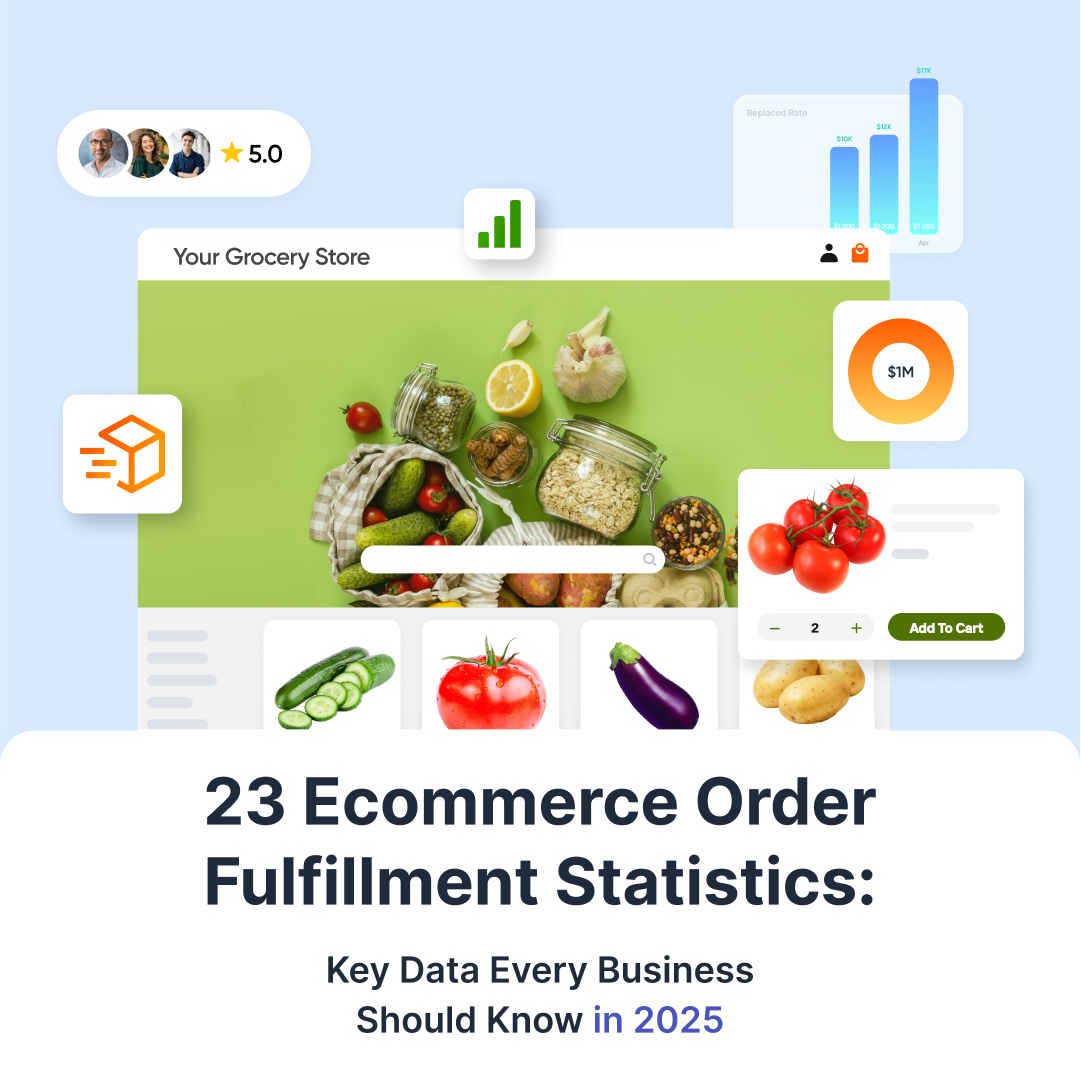


Comprehensive data compiled from extensive research across delivery expectations, fulfillment operations, technology automation, and competitive performance metrics
This represents the most dramatic shift in consumer expectations in ecommerce history, with nearly half of all online shoppers now demanding same-day or next-day delivery as standard service. By April of 2023, Statista data found that 41% of shoppers "hoped to receive" their orders within 24 hours, and a whopping 24% expected a delivery window of just two hours. The expectation has become so embedded that retailers unable to meet these timelines face immediate competitive disadvantage and customer defection. Source: Statista via Roadie
A recent survey by Statista (2023) found that 44% of customers are only willing to wait two days for their order to be delivered. The two-day delivery standard, popularized by Amazon Prime, has become the baseline expectation across all ecommerce channels, regardless of retailer size or industry vertical. This compressed timeline forces businesses to choose between expensive expedited shipping or strategic fulfillment infrastructure investments. Companies partnering with local fulfillment services can meet these expectations cost-effectively while maintaining competitive margins through reduced shipping zones and faster processing times. Source: Meteor Space
This ultra-rapid delivery expectation, concentrated primarily in urban markets, drives the most profitable segment of ecommerce fulfillment services. A whopping 24% expected a delivery window of just two hours and 76.3% want the option to receive packages within three (3) hours of ordering. Businesses serving this demanding customer base command premium pricing while building exceptional loyalty through convenience. The two-hour window requires sophisticated local inventory positioning and last-mile logistics coordination. Sources: Roadie, Capital One Shopping
Starting from $9.25 billion in 2024, this market is forecasted to reach 13.15 billion U.S. dollars by 2030. At 21.2% year-over-year, same-day delivery is growing more than twice as fast as the e-commerce market alone. This explosive growth rate more than doubles the overall ecommerce expansion rate, indicating fundamental consumer behavior shifts toward immediacy. The market dynamics favor fulfillment providers who can capture disproportionate value by serving the highest-margin, most time-sensitive deliveries. Sources: Statista, Roadie
This near-universal expectation means that same-day delivery has shifted from competitive differentiator to market entry requirement across most product categories. 80% of shoppers surveyed want same-day shipping, while 96% of customers consider "fast delivery" to mean same-day delivery. Retailers without same-day capabilities face immediate disadvantage in customer acquisition and retention battles. Sources: Capital One Shopping, Invesp
Extended delivery timeframes directly convert to revenue loss, with over one-third of potential customers walking away from purchases due to speed concerns alone. This abandonment rate represents billions in lost ecommerce revenue annually and demonstrates the critical business impact of fulfillment speed on conversion rates. Local fulfillment dramatically reduces delivery windows, converting these abandoned sales into completed transactions and loyal customers. Source: ReadyCloud
Research shows that 69% of shoppers are less likely to buy from a retailer again if their purchase doesn't arrive within two days of the promised delivery date. Late delivery creates permanent customer loss at an alarming rate, making fulfillment reliability a critical factor in customer lifetime value calculations. The cost of acquiring new customers to replace those lost to delivery failures far exceeds the investment in reliable fulfillment infrastructure. Source: OpenSend
Based on the data we collected, we've calculated the average cart abandonment rate of 70.19%, while 48% of shopping carts are abandoned due to excess shipping fees and taxes added during final checkout. The relationship between shipping costs, delivery speed, and cart abandonment reveals the complex economics of ecommerce fulfillment decisions. High shipping costs often reflect inefficient fulfillment networks requiring long-distance shipping and expedited services to meet customer expectations. Sources: Baymard Institute, SellersCommerce
Time-sensitive purchase decisions, whether for gifts, events, or immediate needs, represent nearly 30% of abandonment cases where customers have clear intent to buy but delivery constraints prevent completion. 28% of consumers have abandoned an online purchase because they needed the items sooner than the provided delivery estimate. This segment offers the highest conversion potential for businesses that can guarantee fast delivery through local fulfillment capabilities. Source: Capital One Shopping
Single delivery failures create permanent customer loss at a rate that makes fulfillment reliability essential for sustainable business growth. The lifetime value impact of losing 14% of customers after any delivery failure demonstrates why businesses invest heavily in fulfillment partnerships that guarantee performance. This statistic drives the premium pricing that reliable fulfillment providers can command in the marketplace. Source: ReadyCloud
The dramatic increase from 41% of shipping costs in 2018 to 53% in 2024 demonstrates how last-mile delivery has become the primary cost driver in ecommerce fulfillment. This trend makes local fulfillment strategies essential for cost control, as reducing last-mile distances provides the most significant opportunity for expense reduction. Companies utilizing local fulfillment networks can cut these costs by 15-37% through zone optimization and proximity advantages. Source: OpenSend
Distributed inventory strategies using local fulfillment centers deliver substantial cost savings by shipping from lower-cost zones and reducing average delivery distances. For heavier parcels, savings reach 37% through shipping zone optimization, making local fulfillment particularly attractive for businesses with diverse product weights. These savings flow directly to improved margins or competitive pricing advantages that drive market share growth. Source: Procurement Tactics
The compound cost of failed deliveries includes redelivery expenses, customer service interactions, and potential order cancellations, making first-attempt success rates critical for profitability. Leading fulfillment providers achieve 95%+ first-attempt success rates compared to industry averages of 90-95%, directly reducing these expensive failure costs. The $17.78 penalty per failed delivery multiplied across thousands of orders creates substantial financial impact that local fulfillment helps eliminate. Source: Store Growers
Advanced automation combined with proximity to customers enables micro-fulfillment centers to achieve dramatic per-order cost reductions through operational efficiency and reduced shipping distances. These facilities, requiring as little as 10,000 square feet, can fulfill orders at 10x the capacity of traditional warehouses while maintaining superior accuracy rates. The cost advantage creates competitive moats for businesses leveraging these advanced fulfillment capabilities. Source: ReadyCloud
Best in class companies achieve 99.9% inventory accuracy, while leading ecommerce companies and 3PL providers often register order picking accuracy rates of 98% and above. The dramatic accuracy gap between best-in-class fulfillment providers and typical operations directly impacts customer satisfaction, return rates, and operational costs. Each fulfillment error costs $50-75 when factoring returns, reshipments, and customer service, making accuracy improvements highly valuable. Sources: NetSuite, Amazon MCF
The rapid adoption of automation technologies represents a fundamental shift in fulfillment operations, with companies investing heavily to meet consumer expectations for speed and accuracy. Robotic picking solutions handle up to 1,000 picks per hour compared to 250-350 for human workers, while AI job optimization boosts task efficiency by 58%. This technological transformation makes partnering with automation-enabled providers essential for competitive fulfillment performance. Source: Statista
The dominance of mobile shopping, projected to reach 75% by 2025, fundamentally changes fulfillment requirements with more frequent, smaller orders requiring faster processing and delivery. Mobile app users achieve 3.5% conversion rates versus 2% for mobile websites, indicating higher intent and expectations for rapid fulfillment. Fulfillment operations must optimize for this mobile-first shopping behavior with real-time inventory and same-day delivery capabilities. Source: BusinessDasher
Artificial intelligence deployment across fulfillment operations provides transformative results, with top-performing organizations investing in AI at twice the rate of competitors. The technology enables 20-30% inventory reductions through enhanced demand forecasting while improving workforce management efficiency. Companies utilizing AI-powered fulfillment providers gain access to these advanced capabilities without significant internal investment. Source: Statista
The widespread adoption of real-time inventory systems improves stock accuracy by 35% and reduces fulfillment times by 23%, enabling fulfillment centers to maintain 99.2% in-stock rates while minimizing inventory investment. This technology integration is essential for meeting consumer expectations for immediate product availability and accurate delivery promises. Businesses partnering with technologically advanced fulfillment providers gain competitive advantages without direct technology investments. Source: McKinsey & Company
The explosive 23.1% CAGR in warehouse robotics investment demonstrates the industry's commitment to automation-driven fulfillment capabilities. Amazon's 520,000 AI-powered robots have cut fulfillment costs by 20% while processing 40% more orders per hour, setting performance benchmarks for the industry. This massive technology investment makes partnering with automated fulfillment providers more cost-effective than building internal capabilities for most retailers. Source: Canary7
The fashion sector's exceptionally high return rates, with some retailers experiencing 40-50% returns, require sophisticated reverse logistics capabilities that specialized fulfillment providers are uniquely positioned to handle efficiently. Gen Z shoppers practicing "bracketing" (buying multiple sizes to return) exemplify the challenge, with 51% engaging in this behavior. Fulfillment centers with streamlined return processing provide competitive advantages in this demanding vertical. Source: Capital One Shopping
As the fastest-growing ecommerce segment through 2030, electronics fulfillment demands specialized capabilities including temperature-controlled environments, careful handling protocols, and often bundled accessory coordination. The 8-10% return rates, while lower than fashion, involve higher-value items requiring precise fulfillment accuracy. Fulfillment providers with electronics expertise deliver both the speed and specialized handling this growing segment requires. Source: Dropoff
eCommerce statistics 2024 highlight that household care and groceries are the fastest-growing eCommerce product categories, with annual growth rates of 19.3% and 16.6%, respectively. The explosive growth in grocery ecommerce, with Amazon's same-day delivery covering 1,000+ cities and expanding to 2,300 by 2025, sets aggressive performance benchmarks across the entire sector. With 81 million US households buying groceries online and 45% preferring home delivery, the sector requires unique capabilities including cold chain management and ultra-fast delivery windows. Source: Magenest

